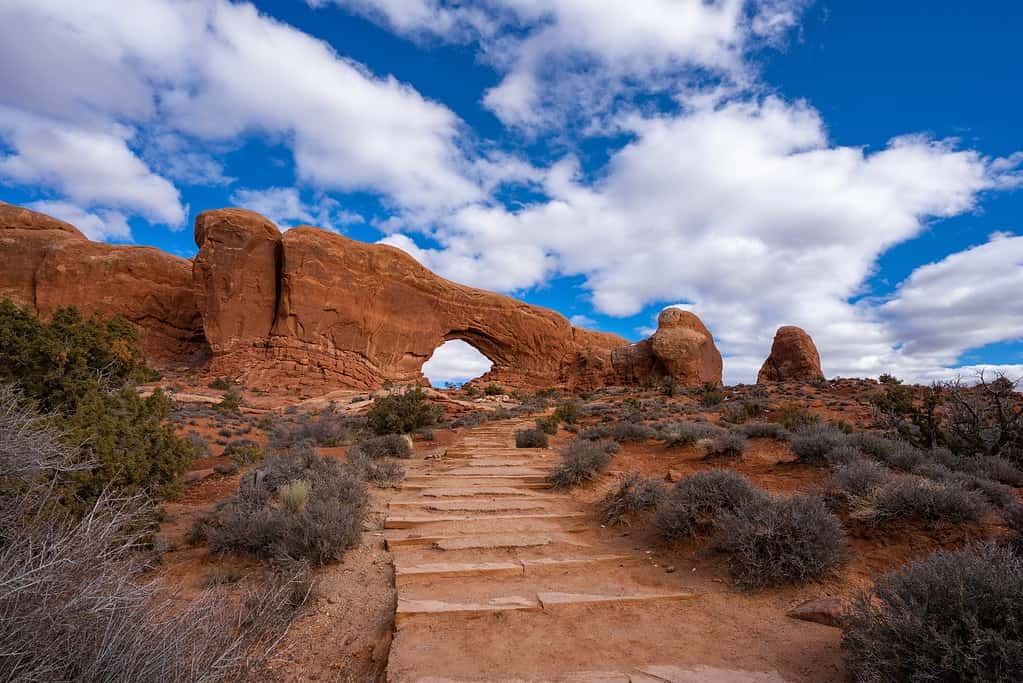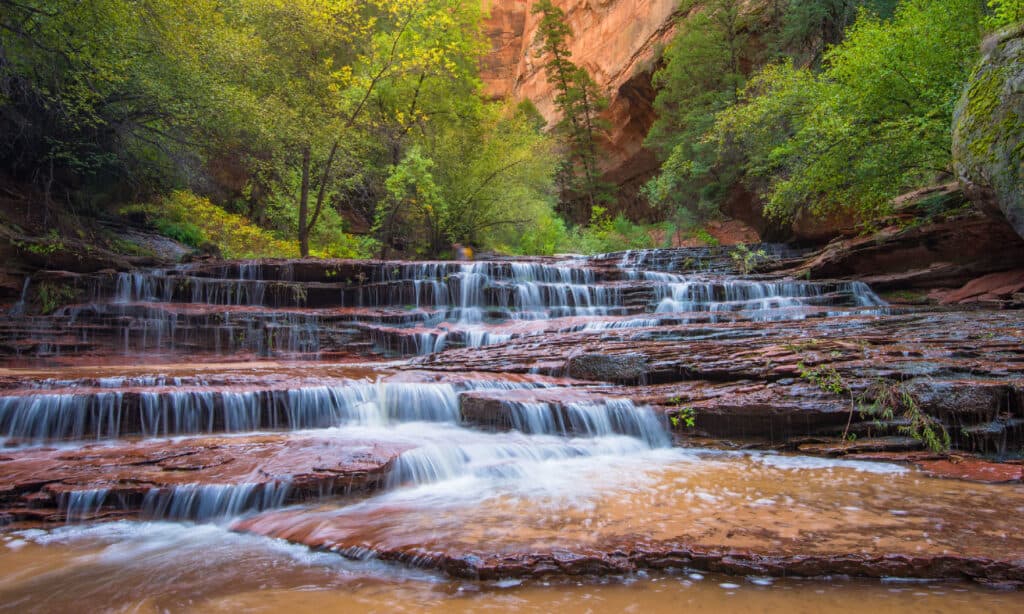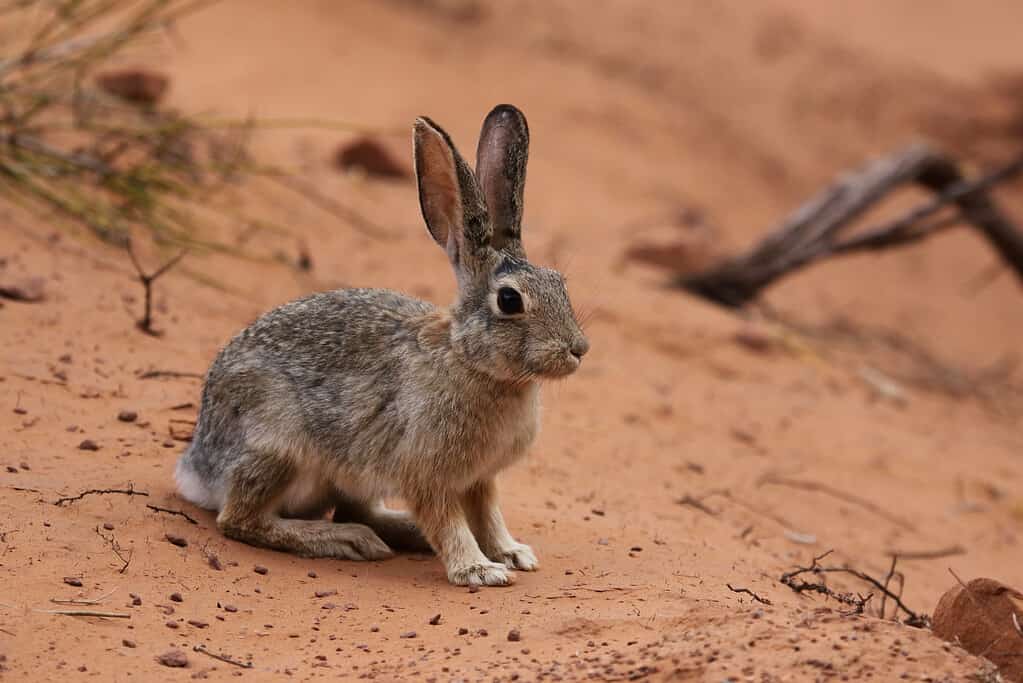The hottest place in Utah, by record temperature, is St. George, a community in southwestern Utah. The hottest day on Utah’s record was in St. George, reaching a scorching 117 degrees Fahrenheit on July 5, 1985. St. George’s temperatures soared to record highs again in 2021. St. George has not only reached the highest temperatures in the state, but it is also the city that has the highest average annual temperature, at 61.1 degrees Fahrenheit. This article describes the local climate, geography, wildlife, and plant life in this sizzling city.
The Climate and Geography of Utah

Stairs ascend to North Window Arch on the Windows Loop Trail in Arches National Park, Utah.
©Margaret.Wiktor/Shutterstock.com
Utah is a western state that borders Arizona to the south, Nevada to the west, Idaho and Wyoming to the north, and Colorado to the east. This southeastern corner of Utah touches three states: Arizona, New Mexico, and Colorado. This is the only place in the United States where four states come together, giving it the nickname “the four corners”! Utah’s geography may be divided into three distinct regions: the Rocky Mountains, the Basin and Ridge Region, and the Colorado Plateau. Each of these vary in their terrain and climate.
The Rocky Mountains region starts in northeastern Utah and travels to the center of the state. This part of Utah contains the state’s highest point: Kings Peak.
The Basin and Ridge region of Utah has both mountains and salt flats. This part of the state is home to the Great Salt Lake, a 1,700-square-mile body of water with a higher salt content than the ocean!
The Colorado Plateau area contains mountains, valleys, and incredible canyons. This part of Utah covers the southern part of the state and has some of the nation’s most iconic National Parks, including Zion Canyon and Bryce Canyon, where you can see gorgeous red rocks, rock pillars, and other incredible landmarks.
Temperatures in Utah
Temperatures vary throughout Utah, also varying depending on the region. In general, Utah has a dry, semi-arid, desert climate. Much of the state is classified as a steppe, or semiarid climate. Utah is also among the driest states in the U.S., with very little humidity compared to other parts of the country. Summers can be very hot and dry, while winters are snowy and cold. However, this does depend on which part of this vast state you are in. The different climate zones vary in humidity level, amount of annual precipitation, thunderstorm activity, and other factors.
The Hottest Temperature Ever Recorded in Utah
The highest recorded temperature in Utah’s history was recorded in St. George on July 5, 1985, when the city reached an incredible 117 degrees Fahrenheit. The community tied its own record again in 2021. That summer, St. George tied its highest recorded temperature when the city reached 117 degrees Fahrenheit for a second time on July 10, 2021.
St. George is located in Washington County, Utah, the county in the state’s southwestern corner, bordering Arizona and Nevada. Here, St. George is located in part of the Mojave Desert at the intersection of the Mojave Desert, Colorado Plateau, and Great Basin region. Washington County is also located in close proximity to multiple state and national parks, including Zion National Park and the Grand Canyon.
This part of the state has an arid desert climate, with cold to mild winters and swelteringly hot summers. This part of the state is much hotter than other parts of Utah, with an average summer temperature of over 100 degrees Fahrenheit.
On July 4, 2007, an area south of St. George reported a scathing temperature of 118 degrees Fahrenheit, which would break the previous record of 117 degrees Fahrenheit. However, experts determined that the equipment used could not guarantee an accurate recording of that level of heat.
The History of the Hottest Place in Utah

Archangel Falls is located in Zion National Park in Washington County, Utah.
©Pung/Shutterstock.com
The area now considered part of Washington County, Utah was inhabited by the indigenous Anasazi people for more than 1,000 years – around 200 B.C. to 1300 A.D. At that time, the Paiute tribe began living in the area. These native people still inhabit the region today. European settlement began with an expedition by the Dominguez-Escalante group in the 1770s, which in initiated the first contact between European settlers and the Paiute people. Other explorers, trappers, and traders would pass through the area following a trader route west to California, but it would not be until the mid-1800s that permanent settlers came to the area to live.
Washington County was formed on March 3, 1852, and named after the first president of the United States, George Washington. At the time, the county seat was the town of Harmony and the boundaries of the county encompassed a width of almost 600 miles. These areas changed several times, with the county seat eventually becoming St. George. The area’s population grew significantly throughout the 20th century, with the most recent census reporting over 191,000 residents of Washington County and nearly 100,000 residents in St. George itself.
Where is St. George, Utah, Located on a Map?
St. George is a city located in the southwestern corner of Utah. It lies at the junction of Interstate 15 and U.S. Route 89 and is just north of the Arizona state line. St. George is the county seat of Washington County and is the most populous city in the area.
The city is situated in the high desert, surrounded by the red rocks and canyons of the Pine Valley Mountains. It is a popular destination for outdoor recreation and is known for its sunny and mild climate.
St. George can be found on a map by looking for the junction of I-15 and U.S. Route 89. It is located just south of the Nevada border and south of the Utah-Arizona state line. It is approximately 150 miles northeast of Las Vegas and 270 miles south of Salt Lake City.
The city is a popular destination for outdoor adventurers who come to explore the surrounding area, which includes Zion National Park, Snow Canyon State Park, and many other attractions. It is also home to the St. George Temple, which is the oldest operating temple of The Church of Jesus Christ of Latter-day Saints.
St. George is a growing city that is home to many businesses and amenities, including restaurants, entertainment, shopping, and more. It is a great place to visit and explore and is sure to offer something for everyone.
Ecology and Wildlife of the Hottest Place in Utah
Washington County, Utah is home to an incredible diversity of wildlife and plantlife.
Plantlife
Contrary to popular assumption, the desert is home to a wide array of diverse plant species that make the desert landscape anything but “barren” or “dead.” Many of these plants are especially well-equipped to thrive in the hot desert environment.
First, Washington County plants include many different cactus species: Engelmann’s hedgehog cactus, golden pricklypear, plains pricklypear, Echonocereus bakeri, silver cholla, kingcup cactus, brown-spined pricklypear, whipple cholla, Johnson’s beehive cactus, buckhorn cactus, spinystar, golden barrel cactus, cottontop cactus, and many others.
Second, this area is home to many types of succulents: artichoke agave, autumn joy sedum, banana yucca, beaked yucca, bear grass, blue yucca, century plant, dragon’s blood stonecrop, elephants food, giant hesperaloe, and numerous others.
Third, the desert ecosystem contains many trees and shrubs: African sumac, apricot trees, apache plume, Arizona cypress, Arizona ash, big sagebrush, blue atlas cedar, butterfly bush, catalpa, crape myrtle, cup-leaf Texas sage, palo verde, desert willow, dwarf peach, fremont cottonwood, fruiting mulberry, holly oak, little leaf ashes, and more.
Fourth, the desert has many different grasses, groundcover species, and vines. Many of these native plants carpet the desert landscape with flowers, thistles, and grass cover.

Utah’s desert landscape is a thriving botanical ecosystem with numerous plants, including many cactus species, such as the
Cactus pediocactuspictured above.
©Cpifbg13/Shutterstock.com
Desert Insects
Over 750 different species of bugs and insects live in the Utah desert! Southwest Utah is home to some incredible unique insects. Some of these are unusually beautiful, while others may give you a creepy-crawly feeling!
For example, you may find a tarantula hawk in Washington County. Tarantula hawks are not tarantulas, nor are they hawks. Rather, this spider wasp species hunts tarantulas to give to larvae for food, catching, stinging, and dragging tarantulas into a nest and hatching an egg in the spider’s abdomen. As the larvae hatch, the tarantula serves as living food for the larvae to devour from the inside out.
Another unique insect is the mourning cloak butterfly, which has a lifespan of 10 to 11 months, making it one of the longest-loving butterflies. Bumblebee robber flies might look like fuzzy bumblebees, but don’t be deceived! These insects attack and devour honeybees that are extracting food from a flower. Similarly, the velvet ant looks like a fluffy ant, but is only in disguise. Velvet ants are parasitic wasps that can deliver a very painful sting. Another fierce predator, which is in abundance in St. George, is the western tiger beetle. These insects gained their name from stalking their prey in a similar fashion to a real tiger.
From beetles to wasps to butterflies, the Utah desert is bursting with interesting and unusual insect species to discover!

Tarantula hawks capture tarantulas to serve as food for their larvae.
©Sari ONeal/Shutterstock.com
Wildlife
Southern Utah’s animal species include a diverse assortment of wildlife, which inhabit Washington County’s varied elevations and terrain.
First, these include many mammals: mountain lions, bobcats, coyotes, gray foxes, kit foxes, raccoons, skunks, deer, jackrabbits, beavers, muskrats, squirrels, bats, and more.
Second, this part of the desert is home to numerous reptiles, including the desert tortoise, spiny softshell turtle, red-eared slider, and many lizards and snakes. Among the lizard population, there is the famous Gila monster, long-nosed leopard lizard, desert horned lizard, zebra-tailed lizard, tiger whiptail, western skink, western banded gecko, and many more. Southern Utah’s snake population includes both venomous and non-venomous snakes. Some of the most unique snake species that live in this area include the great basin rattlesnake, the Mojave Desert sidewinder, regal ringneck snake, and over ten others.
Third, despite being a desert ecosystem, Washington County provides a welcoming habitat for amphibians like the American bullfrog, red-spotted toad, southwestern toad, Great Basin salamander, and tiger salamander.
Lastly, birdwatchers who visit the hottest place in Utah may see dozens of common desert birds. These include golden eagles, bald eagles, sharp-shinned hawks, peregrine falcons, American kestrels, turkey vultures, great horned owls, western screech owls, great blue herons, greater roadrunners, mourning doves, hummingbirds, loggerhead shrikes, white-throated swifts, cactus wrens, house wrens, rock wrens, juniper titmice, chipping sparrows, house finches, goldfinches, and many other birds.

A Desert Cottontail (
Sylvilagus audubonii) sitting in the sand in Arches National Park, Utah.
©Chris Hill/Shutterstock.com
Animals that Thrive in Heat
Since Washington County is the hottest place in Utah, the creatures that live there must be adaptable to the heat. Many of these creatures included above are those that can survive, but also may thrive, in the region’s extremely hot temperatures. Among these are some of the reptiles, which thrive in the desert environment and are cold-blooded creatures that gain heat from the sun. Others are desert bird species, which inhabit cactuses or are otherwise adapted to the specific plants and insects of the Utah desert.
Things to Do in Washington County
If you decide to visit the hottest place in Utah, you are not alone! Despite its record-breaking temperatures, many people visit Washington County. In fact, every year, millions of people visit this region because of its location close to multiple United States’ most incredible national and state parks. Because of its proximity to locations such as the Grand Canyon or Zion National Park, as well as its relative closeness to cities like Las Vegas, Washington County, Utah is a great place to visit for outdoor adventure. Because St. George has relatively mild winters, it is also a popular destination for people who enjoy golfing, hiking, biking, and running all winter long.
Considered part of “Greater Zion,” the southwest corner offers many square miles of adventure, beauty, and natural wonders through its wildlife, geology, and more.
The photo featured at the top of this post is © Iryna Kvarts/Shutterstock.com
Thank you for reading! Have some feedback for us? Contact the AZ Animals editorial team.






